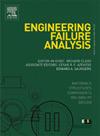Corrosion fatigue analysis of suspenders on continuous suspension bridge under combined action of wind and traffic
IF 4.4
2区 工程技术
Q1 ENGINEERING, MECHANICAL
引用次数: 0
Abstract
Suspenders and displacement-controlled device (DCD) are crucial force transmission components connecting the girder and the main cable in the continuous suspension bridge. These two structures will be subjected to environmental corrosion and fatigue loading simultaneously after the protection system fails. To investigate the safety of structure during the service, a comprehensive framework for corrosion fatigue analysis of continuous suspension bridge under the combined effects of wind and traffic flow was proposed. Taking a three-span continuous suspension bridge with DCD as engineering background, the wind-traffic combined load model was established and the fatigue life of the corroded suspenders was examined. Based on the Multilayer Perceptron algorithm, the impact of load form, environmental grade and DCD type on the corrosion fatigue performance of suspenders was analyzed. The results indicate that the fatigue life of suspender is significantly reduced due to uniform and pitting corrosion of the internal steel wires. The early failure mechanism of suspender is extremely sensitive to corrosion factors. Traffic load is the primary cause of fatigue damage to suspenders. Setting up DCD is beneficial for improving the corrosion fatigue life of the suspenders, and the selection of DCD type mainly depends on the topographical factors of the bridge site.
风和交通联合作用下连续悬索桥吊索的腐蚀疲劳分析
悬索和位移控制装置(DCD)是连接连续悬索桥梁和主缆的重要传力部件。保护系统失效后,这两个结构将同时承受环境腐蚀和疲劳载荷。为了研究结构在服役期间的安全性,提出了在风和交通流共同作用下连续悬索桥腐蚀疲劳分析的综合框架。以 DCD 三跨连续悬索桥为工程背景,建立了风-交通联合荷载模型,并考察了腐蚀悬索的疲劳寿命。基于多层感知器算法,分析了荷载形式、环境等级和 DCD 类型对吊带腐蚀疲劳性能的影响。结果表明,由于内部钢丝的均匀腐蚀和点状腐蚀,吊带的疲劳寿命明显缩短。悬挂装置的早期失效机制对腐蚀因素极为敏感。交通负荷是悬挂装置疲劳损坏的主要原因。设置 DCD 有利于提高悬挂装置的腐蚀疲劳寿命,而 DCD 类型的选择主要取决于桥址的地形因素。
本文章由计算机程序翻译,如有差异,请以英文原文为准。
求助全文
约1分钟内获得全文
求助全文
来源期刊

Engineering Failure Analysis
工程技术-材料科学:表征与测试
CiteScore
7.70
自引率
20.00%
发文量
956
审稿时长
47 days
期刊介绍:
Engineering Failure Analysis publishes research papers describing the analysis of engineering failures and related studies.
Papers relating to the structure, properties and behaviour of engineering materials are encouraged, particularly those which also involve the detailed application of materials parameters to problems in engineering structures, components and design. In addition to the area of materials engineering, the interacting fields of mechanical, manufacturing, aeronautical, civil, chemical, corrosion and design engineering are considered relevant. Activity should be directed at analysing engineering failures and carrying out research to help reduce the incidences of failures and to extend the operating horizons of engineering materials.
Emphasis is placed on the mechanical properties of materials and their behaviour when influenced by structure, process and environment. Metallic, polymeric, ceramic and natural materials are all included and the application of these materials to real engineering situations should be emphasised. The use of a case-study based approach is also encouraged.
Engineering Failure Analysis provides essential reference material and critical feedback into the design process thereby contributing to the prevention of engineering failures in the future. All submissions will be subject to peer review from leading experts in the field.
 求助内容:
求助内容: 应助结果提醒方式:
应助结果提醒方式:


